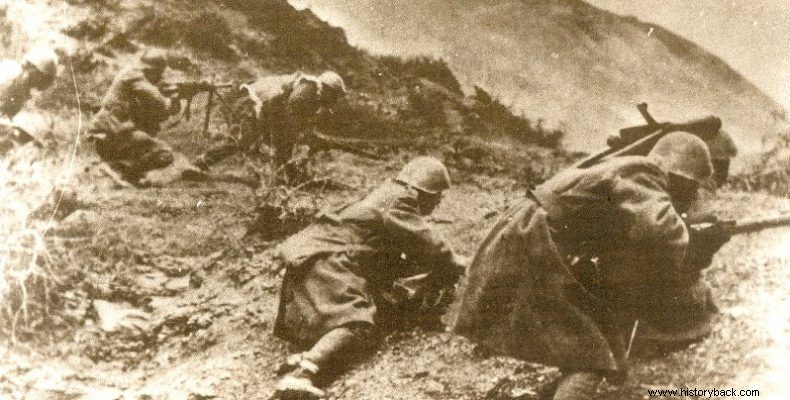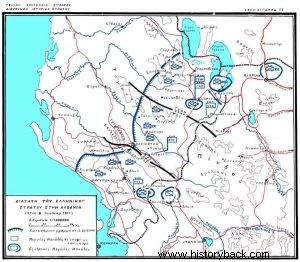
With the occupation of Albania, in April 1939, Italy implemented its conquest plan against Greece, which initially envisaged the surprise occupation of Epirus and Corfu and, in a second stage, the occupation of of Western Macedonia. Faced with the constant challenges of the Italians and the developments that shocked all of Europe, the Greek side had not remained inactive. The country's first defense plan, which took into account the threat from Italy, was drawn up in 1939 (plan IB). It provided for the concession of a part of Epirus as far as Arachthos, and defense in the location of Arachthos – Zygos Metsovo. Later, when the defensive preparation progressed satisfactorily, a second plan (IBa) was created, which provided for the defense of the advanced border line Kalamas – Elaia (Kalpaki) – Gamila – Smolikas – Stavros (Grammos), without serious territorial concessions.
The Italian plan provided for a surprise invasion with fast-moving means before the mobilization and concentration of the Greek army was even completed. The main burden of the defense organization of Greece was, therefore, carried by the Epirus front, and the VIII Division of the Ioannina. On the initiative of its commander, Major General Charalambos Katsimitros, it was decided to concentrate all the preparation in the area of Elia (Kalpaki), the control of which ensured not only Epirus, but also the crossings to Thessaly and Macedonia. The site had been organized by mid-1939 to a satisfactory level, particularly on the heights on either side of the Kalamas River ford. Thus, on October 27, 1940, just one day before the declaration of war, the VIII Division had completed its mobilization and its Commander was assuring the GES headquarters that "no Italians will pass through Kalpaki".
The VIII Division had been reinforced with the Headquarters of the III Infantry Brigade and some Infantry and Artillery units. Its forces included four Infantry Regimental Commands, 15 Infantry Battalions, 15 Artillery Companies, 5 Infantry Escort Platoons, 2 Movement Machine Gun Battalions, and 1 Divisional Reconnaissance Group. The Italian army had absolute superiority in tanks and air support (about 400 planes). In the area of Epirus was the XXV Army Corps with four divisions:the 23rd Infantry Division "Ferrara", the 131st Armored Division "Centauri", the 51st Division "Sienna" and the Cavalry Division (21 Infantry battalions, 1 Versailles battalion, 41 artillery divisions , 2 mortar battalions, 3 Cavalry regiments, 1 headquarters, 90 tanks, total strength about 41,200 men).
Before the Italians' ultimatum had even expired, in the early hours of October 28, 1940, Italian forces began to advance along the entire Epirus front. The Greek advance units, after resisting, collapsed in the area of Kalpaki, according to the plan of the VIII Division, which had installed its headquarters there. Until November 1, the Italians were limited to ground and air reconnaissance, while their artillery and air force attacked the heights of Grabala, Kalpaki and Assonisa, but with insignificant results. The organized attack began on the morning of November 2. Italian aircraft in successive waves bombed Grabala, Kalpaki, the Vellas Monastery, the Ioannina airport and the Mazaraki bridge, but again without the desired results. This was followed, at noon, by a heavy bombardment by the Italian artillery, but despite the fact that more than 2,000 shells were fired and the heights were literally dug out, the losses were again minimal, thanks to the effective preparation of the Greeks.
The same fate had the attack of the two Italian divisions "Ferrara" and "Centauri", which moved against the heights of Grabala and Psilorrachis. Thanks to the successful action of the Greek artillery, the attack was repulsed with serious losses for the Italians. Nevertheless, on the same night, a battalion of Albanians and elite Italian units with a surprise attack captured the Grabala hill and overthrew the company of the 15th Regiment there. The heavy snowstorm that followed prevented any further action on either side, but by dawn on 3 November the Greeks recaptured the high ground. The Italians left in Grabala 20 dead, 6 prisoners and many weapons and ammunition. Throughout the day the two sides exchanged artillery fire, while the Italian air force bombarded Kalpaki and Sudena. In the afternoon the Italians launched a new attack against the heights of Grabala, Psilorrachis and Assonisa. 70-80 tanks of the "Centaur" Division, flanked by about 50 motorcyclists, arrived at a distance of 500-600 m from Kalpaki.
This attack, however, was intercepted by the Greek artillery and anti-tank defense (trenches and minefield). Many Italian tanks were destroyed, while the rest retreated with heavy damage. The Greek losses on this day were 35 dead and wounded, officers and soldiers. This failure of the enemy revived the morale of the Greeks, who had managed to effectively deal with the two points of superiority of the Italians:the tanks, which they were seeing for the first time, and the air force. After their successive failures, the Italians were forced to postpone the all-out attack they had planned and limited themselves to artillery fire and aerial bombardment, especially against Grabala.
On the morning of November 5, the Italians bombarded the areas of Grabala and Vrontismene, but during the night the VIII Division, without being noticed, had abandoned its positions. At the same time, the Italian tanks tried to cross the Kalamas river, but to no avail, because they stopped in the marshy ground. Sporadic shots were repeated the following day, while on November 7 the last general attack by the Italians took place, who tried to bypass the Kalpakio junction and head towards Ioannina. They bombarded the same positions and temporarily occupied Grabala, however, the hill eventually remained in Greek hands after units of the 15th Infantry Regiment annihilated the Italian force of pickets, who wore metal emblems with the phrase "soldiers of 4 death" on their chests. The losses of the Italians were 45 dead and 7 prisoners, while the Greeks were 1 officer dead and 1 wounded, 11 soldiers dead and 33 wounded. On 8 November the offensive activity of the Italians ceased and General Praska, Commander of the Italian troops in Albania was replaced by Sodu. The Italian forces began to retreat defending the entire length of the front, maintaining only one bridgehead south of the Kalamas River.

SOURCE:DIS/GES
